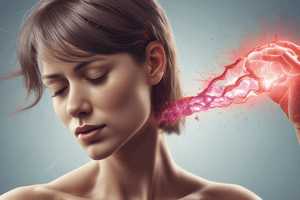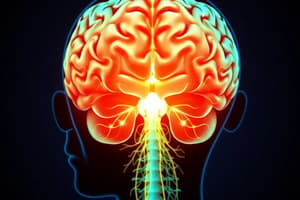Podcast
Questions and Answers
What is a characteristic symptom of Cluster Headaches?
What is a characteristic symptom of Cluster Headaches?
- Abdominal discomfort
- Severe throbbing or stabbing pain (correct)
- Visual disturbances
- Bilateral pain
Which type of seizure is characterized by brief lapses in awareness and often mistaken for daydreaming?
Which type of seizure is characterized by brief lapses in awareness and often mistaken for daydreaming?
- Clonic seizures
- Atonic seizures
- Tonic seizures
- Absence seizures (correct)
What primary feature distinguishes Multiple Sclerosis?
What primary feature distinguishes Multiple Sclerosis?
- Acute inflammatory attacks
- Only affects motor function
- Progressive and irreversible damage (correct)
- Presence of deep tendon reflexes
Which symptom is NOT commonly associated with Parkinson’s Disease?
Which symptom is NOT commonly associated with Parkinson’s Disease?
What is a typical early manifestation of Amyotrophic Lateral Sclerosis?
What is a typical early manifestation of Amyotrophic Lateral Sclerosis?
Which of the following accurately describes the motor dysfunctions associated with Parkinson’s Disease?
Which of the following accurately describes the motor dysfunctions associated with Parkinson’s Disease?
Which of the following statements correctly describes developmental reflexes in relation to cerebral palsy?
Which of the following statements correctly describes developmental reflexes in relation to cerebral palsy?
Which type of meningitis is usually characterized by flulike symptoms and requires throat cultures for diagnosis?
Which type of meningitis is usually characterized by flulike symptoms and requires throat cultures for diagnosis?
Brain injuries can be classified into which of the following categories?
Brain injuries can be classified into which of the following categories?
Increased intracranial pressure can lead to which of the following symptoms or conditions?
Increased intracranial pressure can lead to which of the following symptoms or conditions?
Which of the following manifestations is typically associated with spinal cord injury?
Which of the following manifestations is typically associated with spinal cord injury?
Which of the following risk factors is associated with meningitis?
Which of the following risk factors is associated with meningitis?
What is a defining feature of a traumatic brain injury (TBI) that indicates a significant alteration in consciousness?
What is a defining feature of a traumatic brain injury (TBI) that indicates a significant alteration in consciousness?
Which of the following is NOT a typical manifestation of increased intracranial pressure (ICP)?
Which of the following is NOT a typical manifestation of increased intracranial pressure (ICP)?
The American Spinal Injury Association (ASIA) classification system categorizes spinal cord injuries based on which of the following factors?
The American Spinal Injury Association (ASIA) classification system categorizes spinal cord injuries based on which of the following factors?
What is a common cause for the development of a cerebral aneurysm?
What is a common cause for the development of a cerebral aneurysm?
Which symptom is typically associated with spinal shock following a spinal cord injury?
Which symptom is typically associated with spinal shock following a spinal cord injury?
In the context of cerebrovascular accidents, which type primarily involves the blockage of blood vessels?
In the context of cerebrovascular accidents, which type primarily involves the blockage of blood vessels?
Which complication is specifically associated with increased intracranial pressure?
Which complication is specifically associated with increased intracranial pressure?
What mechanism contributes to the autonomic dysreflexia that can occur after a spinal cord injury?
What mechanism contributes to the autonomic dysreflexia that can occur after a spinal cord injury?
Study Notes
Cluster Headaches
- Characterized by short bursts of unilateral orbital pain.
- Pain distribution follows the trigeminal nerve, featuring unilateral autonomic symptoms.
- Symptoms include severe throbbing/stabbing pain, lacrimation, ptosis, and sweating.
- Diagnosis is based on medical history and physical examination.
- Treatment options include oxygen therapy and triptans for acute attacks, with preventive therapy using verapamil.
Seizure Disorders
- Defined as transient physical or behavioral alterations due to abnormal brain electrical activity.
- Epilepsy has specific definitions along with incidence and prevalence statistics.
- Febrile seizures commonly occur in children.
Seizure Disorders: Clinical Manifestations
- Seizures categorized into focal (simple/complex) and generalized types.
- Generalized seizure types include absence, tonic, clonic, myoclonic, atonic, and tonic-clonic, with some unknown types.
Multiple Sclerosis (MS)
- A chronic inflammatory, immune-mediated disease leading to demyelination and axonal degeneration in the central nervous system.
- Genetic predisposition may contribute to MS development.
- Theoretical mechanisms of demyelination involve immune system involvement.
MS: Clinical Manifestations
- Features relapses and remissions, including sensory symptoms, visual disturbances, motor spasticity, and cognitive changes.
- Other symptoms comprise bladder and bowel dysfunction, fatigue, and transverse myelitis.
Parkinson’s Disease
- Characterized by neuron loss in the substantia nigra resulting in dopamine depletion.
- Affects coordinated muscle movement through basal ganglia dysfunction.
- Multiple cellular level abnormalities contribute to disease progression.
Parkinson’s Disease: Clinical Manifestations
- Key symptoms encompass tremors, akinesia, rigidity, and postural instability.
- Other motor dysfunctions include masked facial expression, micrographia, and speech difficulties.
- Nonmotor symptoms may involve mood changes, cognitive decline, and dementia.
Amyotrophic Lateral Sclerosis (ALS)
- Involves damage to motor neurons in the cerebral cortex, brainstem, and spinal cord.
- Early signs include foot drop, lower extremity weakness, hand weakness, and dysarthria.
- Symptoms in older children and adults can present as headaches, nausea, and balance issues.
Spina Bifida
- Second most common birth defect in the U.S., classified as a neural tube defect.
- Severity varies, with different forms including spina bifida occulta, meningocele, and myelomeningocele.
- Surgical intervention is necessary for meningocele and myelomeningocele cases.
Cerebral Palsy (CP)
- Nonprogressive disorders arising in early childhood affecting motor movement and coordination.
- Resultant from brain abnormalities or damage to the cerebellum.
- Risk factors include prematurity, low birth weight, and hypoxia.
CP: Clinical Manifestations
- Movement disorders categorized into spastic, dyskinetic, and ataxic subtypes.
- Development assessed via reflexes, motor tone, and posture.
Meningitis
- Inflammation of the meninges, often due to infection.
- Symptoms resemble influenza; diagnosis includes throat cultures, lumbar puncture, and imaging.
- Treatment typically involves antibiotics, antivirals, and hydration management.
Encephalitis
- Brain inflammation, often from infection, featuring flulike symptoms.
- Diagnosis uses physical exams, imaging, and lumbar puncture.
- Supportive treatment is the primary strategy, coupled with preventive measures.
Zika Virus Disease
- A flavivirus primarily transmitted by mosquitoes, presenting flulike symptoms.
- Diagnosis based on medical history and body fluid analysis.
- Supportive treatment is essential; prevention is crucial.
Brain Injuries
- Caused by blunt force trauma or penetrating wounds.
- Disrupts normal brain function with varying complications.
- Two main types: closed and open injuries.
TBIs: Clinical Manifestations
- Symptoms can develop slowly or suddenly; Glasgow Coma Scale assesses severity.
- Neurobehavioral changes indicate disruptions in consciousness levels (coma, vegetative state).
Increased Intracranial Pressure (ICP)
- Result of increased cranial cavity fluid or tissue volume inconsistencies.
- The Monro-Kellie hypothesis explains pressure-volume relationship affecting ICP and cerebral perfusion.
- Compensation mechanisms exist and herniation can be a severe complication.
ICP: Clinical Manifestations
- Symptoms vary by age; include decreasing consciousness, vomiting, elevated blood pressure, bradycardia, and fixed, dilated pupils.
- Infants show separated sutures and bulging fontanelles; children/adults exhibit severe headaches and lethargy.
Hematomas
- Blood collections due to ruptured vessels, classified as epidural, subdural, intracerebral, and subarachnoid.
- Diagnosis involves patient history, physical examination, and imaging techniques.
- Surgical removal is often necessary for treatment.
Spinal Cord Injuries (SCIs)
- Result from direct spinal cord trauma or indirect damage to adjacent structures.
- Primary (immediate) and secondary injuries may occur, often leading to edema and spinal shock.
SCIs: Clinical Manifestations (1 of 2)
- Significant neurological loss includes flaccid paralysis and loss of sensation.
- Neurogenic shock manifests with vasodilation and loss of sympathetic tone.
SCIs: Clinical Manifestations (2 of 2)
- Autonomic dysreflexia results in unregulated heart rate and vascular responses.
- Severity of dysfunction is determined by injury level, with classification according to ASIA standards.
Cerebral Vascular Accident (CVA) (1 of 2)
- Interruption of cerebral blood flow, categorized as ischemic or hemorrhagic.
- Ischemic strokes include thrombotic and embolic types; transient ischemic attacks (TIAs) present similarly but are temporary.
CVA: Clinical Manifestations (2 of 2)
- Symptoms of ischemic strokes show sudden loss of focal brain functions, varying by the affected cerebral region.
- Diagnosis relies on detailed history, physical examination, and imaging to differentiate stroke type.
CVA: Treatment
- Early intervention is crucial; ischemic strokes are treated with thrombolytics and potential surgical procedures.
- Hemorrhagic strokes need surgical repair to address aneurysms or malformations.
Cerebral Aneurysm
- Defined as localized arterial outpouching in the brain, often asymptomatic until ruptured.
- Diagnosis includes CT, MRI, and cerebral arteriography; medical repair is necessary upon rupture.
Arteriovenous Malformations (AVMs)
- Marked by abnormal connections between arteries and veins, potentially causing hemorrhages and seizures.
- Diagnosis utilizes imaging; treatment may involve excision or focused radiation therapy.
Migraine Headaches
- Severe, debilitating headaches linked to systemic symptoms, categorized as migraine with or without aura.
- Caused by waves of neuronal and glial depolarization, leading to neurogenic inflammation.
Migraine: Clinical Manifestations
- Prodromal symptoms may include irritability and cravings; visual and sensory auras can occur.
- Characterized by throbbing pain, nausea, vomiting, photophobia, and phonophobia.
Tension-Type Headaches
- Result from nerve hypersensitivity; can be episodic or chronic.
- Typically mild to moderate, described as dull or tight sensations.
- Diagnostic approach involves medical history, while treatment includes NSAIDs and other analgesics.
Studying That Suits You
Use AI to generate personalized quizzes and flashcards to suit your learning preferences.
Related Documents
Description
This quiz covers preventive measures for cluster headaches and seizure disorders. It includes key features, diagnosis, and treatment options for each condition. Test your knowledge on effective therapies and clinical symptoms associated with these neurological issues.




